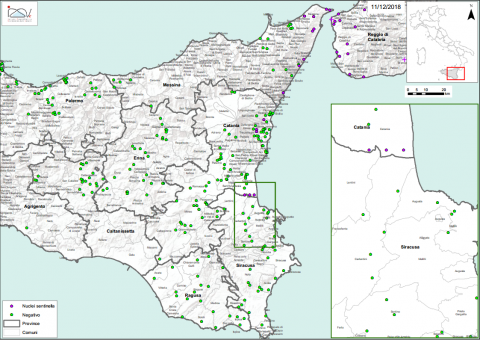A new sentinel apiary was confirmed positive (purple cross on the maps) on 12th. November 2018 in Villa San Giovanni situated in the protection zone of 30 km (Figure 1 and Table 1). Adults and a hundred of larvae of Aethina tumida were detected on this apiary. Another sentinel apiary was confirmed positive on June 2017 in this municipality.
As of 11th. December 2018, four sentinel apiaries and one natural colony were found infested (Table 2) in the province of Reggio di Calabria.
The sanitary situation in Sicily and in the province of Cosenza remains unchanged (Figure 3 and Figure 4).
 Please click on the map to access the figure with a higher resolution
Please click on the map to access the figure with a higher resolution
Figure 1: The 30 km protection zone for monitoring A. tumida in Calabria (dated from 11th. December 2018)

Please click on the map to access the figure with a higher resolution
Figure 2: The 100 km surveillance of A. tumida in the rest of Calabria and Sicily (dated from 11th. December 2018)

Please click on the map to access the figure with a higher resolution
Figure 3: The surveillance of A. tumida in Sicily (dated from 11th. December 2018)

Please click on the map to access the figure with a higher resolution
Figure 4: The 10 km protection zone for monitoring A. tumida in Cosenza (dated from 11th. December 2018)
As of 26th. November 2018, there is no new evidence of A. tumida infestation reported on the website of the Italian National Reference Laboratory. The last update was made on 18th. September. At that time, four cases of infestation by A. tumida were identified in the province of Reggio Calabria in the South of Italy:
- Three sentinel apiaries were confirmed positive (purple crosses on maps) whose two were situated in the protection zone of 30 km (Figure 1 and Table 1). The first one was confirmed on August 1st. in the municipality of Palmi where adults and a larva were detected. An outbreak was discovered in the same municipality in March 2017. The second sentinel apiary was confirmed positive on August 7th. in the municipality of Brancaleone situated approximately 15 km away from the protection zone on the south-east coast of the province of Reggio Calabria. Adults of SHB were detected. The last sentinel apiary was confirmed positive in Rosarno on September 4th. This sentinel apiary was infested with adults and larvae. It was situated approximately 12 km away from the outbreak confirmed in Laureana Di Borello.
- One outbreak was confirmed on August 2nd. in the municipality of Laureana Di Borello (red cross on maps) in the protection zone of 30 km (Figure 1 and Table 2). It corresponds to a natural swarm which was infested by adults and larvae of SHB. Another natural swarm was discovered infested with larvae in the same municipality in April 2017.
It has to be noted that not all the inspections scheduled in the rest of the Calabria region and in Sicily have not yet been reported when this news is published (Figure 2).
The sanitary situation in Sicily remains unchanged (no new case discovered since the year 2014) (Figure 3).
No new outbreaks have been discovered in the province of Cosenza (situated in the North of Calabria) since September 2016 (Figure 4).
The regular reappearance of cases in the infested zones since 2014 show that the small hive beetle remains present in the zones.
The surveillance plan implemented in 2018 follows the monitoring scheme put in place in the previous years. Surveillance is still strengthened in Aethina-free areas such as Sicily and the rest of Italy (excluding the protection zones) to guarantee the free status of these territories (Figure 4). Changes were brought to the monitoring scheme notably a reduced number of apiaries to be inspected in the protection zone was planned (corresponding to an expected prevalence of 10% with a confidence interval of 95% instead of an expected prevalence of 5% applied the previous years). This reduction along with the implementation of sentinel apiaries situated in strategic locations (i.e. on the coast in front of Sicily, along the Ionian Coast, along the frontiers with Vibo Valentia and Catanzaro, in Vibo Valentia) suggest an evolution of the objectives towards a control of SHB circulation and a containment of the infestation in the protection zone.
Note: the Commission Implementing decision (EU) 2017/370 of March 1st. 2017 removed Sicily from the list of areas subject to protective measures in relation to SHB in Italy and extended the period of application of certain protective measures until 31st. March 2019.

Please click on the map to access the figure with a higher resolution
Figure 1: The 30 km protection zone for monitoring A. tumida in Calabria (dated from 18th. September 2018)

Please click on the map to access the figure with a higher resolution
Figure 2: The 100 km surveillance of A. tumida in the rest of Calabria and Sicily (dated from 18th. September 2018)

Please click on the map to access the figure with a higher resolution
Figure 3: The surveillance of A. tumida in Sicily (dated from 18th. September 2018)

Please click on the map to access the figure with a higher resolution
Figure 4: The 10 km protection zone for monitoring A. tumida in Cosenza (dated from 18th. September 2018)

